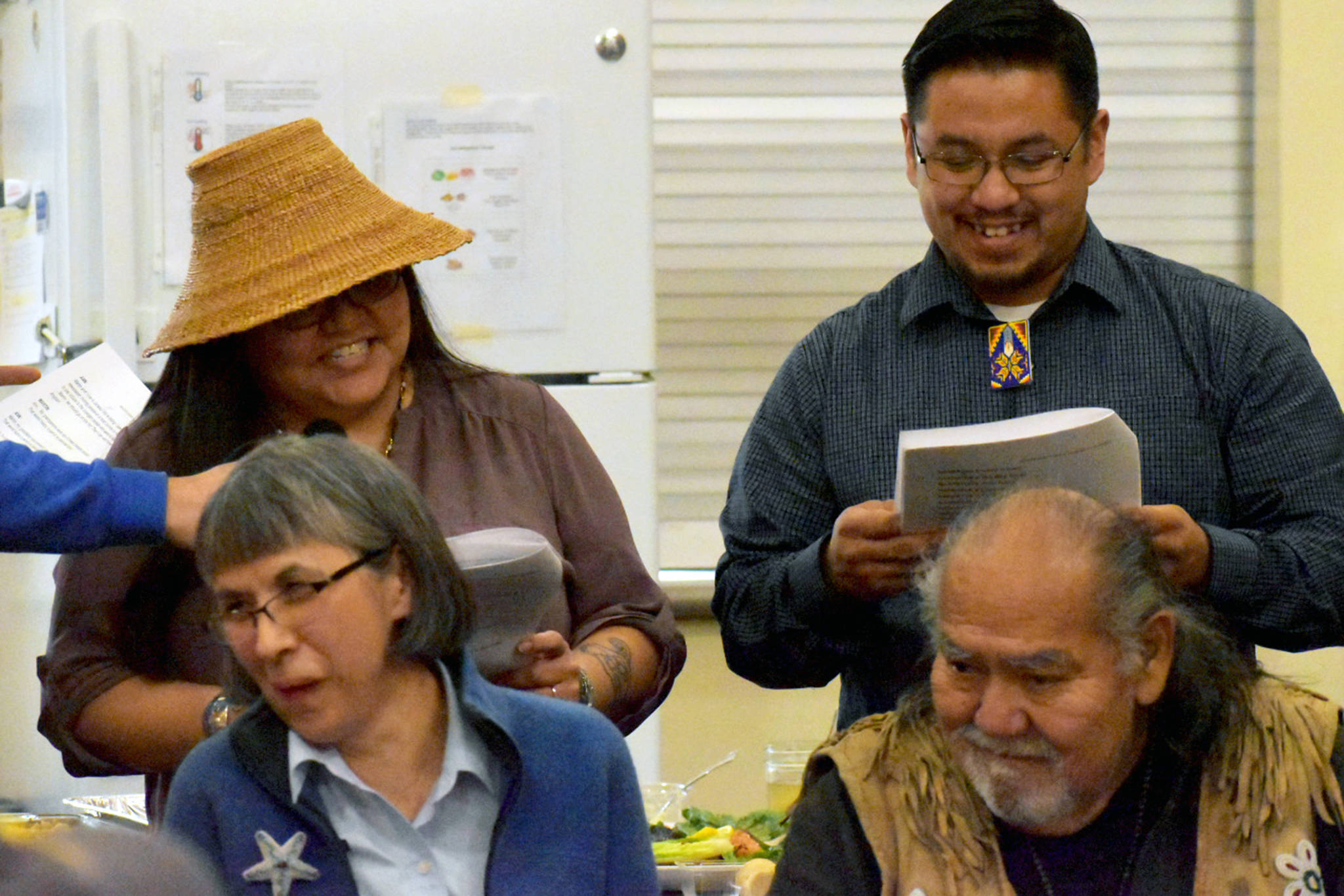For Anne Stepetin, a Tlingit Native from Angoon, it never gets easier to talk about the story of her family’s World War II history.
At a potluck at Northern Light United Church on Monday, tears welled in Stepetin’s eyes as she and her husband Martin shared a short part of their story weaving Juneau’s history with that of World War II. Both had grandparents who were interned in camps during the war. Anne’s grandfather Bill Samato was forced to a camp in Idaho for Japanese-Americans. Martin’s grandparents, Heritina (Misikin) Krukoff and Agafon Krukoff Jr., were taken from St. Paul Island to camps at Funter Bay on Admiralty Island.
The Stepetin’s story is one of 10 which will be featured on Juneau’s new audio history signs that will be implemented downtown this summer.
“It never gets easier to talk about,” Anne Stepetin said. “We took quite a bit of time when we were recording just to get through the emotions to be able to speak so that people could hear the story. There was a lot of changing our voices so that the story could be heard without people seeing us. It was a little different doing it live in front of other people because we couldn’t start over or do it again. But it went well tonight. The emotions never stop flowing when we share our story and it’s just been an honor to be the wife of a man who really has a passion for making a better world for our children.”
[More than just a Gold Rush town: New audible signs seek to tell broader story of Juneau]
Their story will be on sign No. 10, which will be positioned in front of the Alaska State Museum. Monday was one of the only times any of the 10 recordings will be performed live.
Ten of 40 wayfinding signs will feature scannable QR codes — the omnipresent Rorschach-like patches often seen on placards and event tickets — that will link to two- to five-minute recordings of stories about Juneau.
Martin Stepetin said they got involved with the Juneau Voices Audio Wayfinding Project project when he was campaigning for the Juneau Board of Education.
“Turns out we had a unique enough story to make one of the 10 voices that will be on these buttons all throughout Juneau,” Martin Stepetin said. “We are really honored.”
Ryan Conarro, Juneau artist, member of New York-based Ping + Chong Company and co-artistic collaborator and facilitator for the Juneau Voices Audio Wayfinding Project, said the project is about Juneau and it’s about people’s sharing of their first person lived experiences in their own words and voices.
“There’s a real power and potency in the personal storytelling, and that started to become something tangible and visceral these past two weeks as we were recording,” Conarro said. “We’re starting to hear these the way that the listener who experiences the audio walk is going to hear them and that’s really exciting.”
In order to find the 10 stories, Conarro and co-artistic collaborator and facilitator Lillian Petershoare said they really threw open the doors to find people to participate, as well as doing some targeted visits to people who they hoped would be involved. There were three residencies, two in the fall and one ongoing. They started with several story circles and interviews, and narrowed them down to 10 diverse stories. One requirement was that the stories had to be lived experiences, not second-hand accounts, and another that the stories had to come from people who currently live in Juneau.
But they aren’t creating a walking tour of the history of Juneau, Conarro said.
“It’s place-based,” Conarro said. “That’s really key. Each story has a sense that this happened right here in this location. Or this happened right over there, but you can see it from here. When you hear the final piece you’ll hear people say, ‘I was right there across the street,’ or ‘Look up at the mountain, that’s where we were,’ so it really orients the listener in space and transports them to another time.”
He said he hopes the stories, which range from storytellers ages 30-70, invite a critical look at history, especially the ways Alaska Natives were oppressed in the past. He said that raising awareness of those memories and those stories can help the community do better, and the City and Borough of Juneau is behind that message.
“I think our stories range from some that really dive very directly into some critical history, some hard tough questions and memories, and some that have a lightness to them, too,” Conarro said. “More playful memories, with the kind of vivid sensations of Juneau, so you get this kind of panorama that this has been both a beautiful and a really complicated place over the years.”
The last line of the Stepetin’s story says, “World history is what ties our personal stories.” That message resonated to David Katzeek, one of the Tlingit Eagle narrators. In symbiotic balance, the other narrator is a Raven.
“The voices of our ancestors were sounding over the earth tonight,” Katzeek said after the performance of the sign 10 story at Monday’s potluck. “That was their voices calling out. And to me this project was a very significant project because in our culture we call each other ‘Aan Yátx’u Sáani’ which means most precious beloved children of the earth. And as you heard the voices of the different characters that are in this, it was as if the earth was crying out for recognition and acknowledgment. This is a part in western civilization that is so often missed.”
• Mollie Barnes is a freelance reporter in Juneau.

